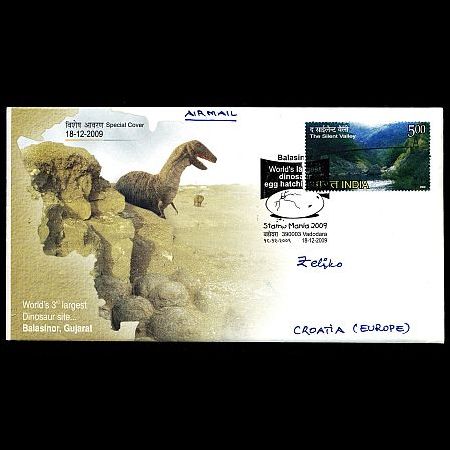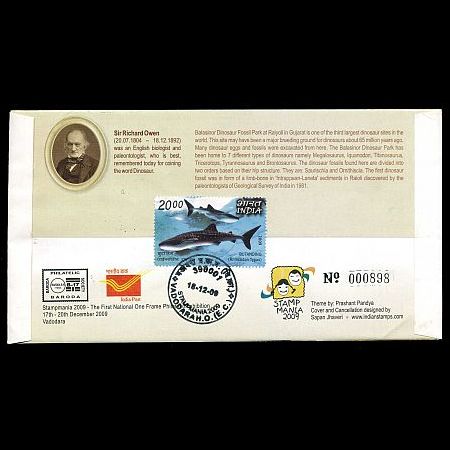India 2009 "Stampmania: Balasinor Dinosaur Fossil park"
| <prev | back to index | next> |
| Issue Date | 18.12.2009 |
| ID | Category: pF |
| Designer | Theme by Prashant Pandya, cover and cancellation designed by Sapan Jhaveri |
| Covers in set | 1 |
| Emission/Type | commemorative |
| Places of issue | |
| Size (width x height) | |
| Printed by | |
| Quantity | |
| Issuing Authority | India Post |

All philately exhibitions produce special covers, booklets and other postal stationary. Any philately exhibition is incomplete without special issues. During Stampmania 2009 (17-20 December, 2009) a souvenir, a carried cover and four special covers (without imprinted stamp), one for each day, were issued.
One of these covers is dedicated to Balasinor Dinosaur Fossil park at Raiyoli in Gujarat - one of the third largest Dinosaur sites in the world.
The stamp on the cover above is "The Silent Valley", issued on November 15th 2009, MiNr.: 2434, Scott: 2373. The stamp has no relationship to the cover and was used to allow commemorative cancellation.
This site may have been a major breeding ground for dinosaurs about 65 million years ago. Many dinosaur eggs and fossils were excavated from here. The Balanasinor Dinosaur Park has been home to 7 different types of dinosaurs namely Megalosurus, Iguanodon, Titanosaurus, Triceratops, Tyrannosaurus and Brontosaurus. The dinosaur fossils found here are divided into two orders based on their hip structure. They are Saurischia and Ornithischia. The first dinosaur fossil was in form of a limb-bone in "Intrappean-Laneta" sediments in Raioli discovered by the paleontologists of the Geological Survey of India in 1981.In the early 1980s, palaeontologists stumbled upon dinosaur bones and fossils during a regular geological survey of this mineral-rich area. The find sent ripples of excitement through neighbouring villages and many residents picked up fossilised eggs, brought them home and worshipped them. Since then, excavations have thrown up a veritable trove of dinosaur remains including eggs, bones, and a skeleton, which are now kept in a Calcutta (Kolkata) Museum bringing hordes of scientists and tourists to Balasinor.
Piecing together the evidence in Balasinor, researchers now believe that Gujarat is home to one of the largest clutch of dinosaur hatcheries in the world. At least 13 species of dinosaurs lived here, possibly for more than 100 million years until their extinction some 65 million years ago. The soft soil made hatching and protecting eggs easier for the animals. So well-protected are the fossilised eggs found here that many researchers call them the best-preserved eggs in the world after the ones found in Aix-en-Provence in France.
 |
 |
|
| The reverse side of unused cover is here |
References:

|
- Technical details and official press release:
Stampmania, PhilatelyNews (doesn't exist anymore). - Balasinor Dinosaur Park:
Wikipedia, BBC.
Acknowledgements:
- Many thanks to Dr. Peter Voice from Department of Geological and Environmental Sciences, Western Michigan University, for the draft page review and his valuable comments.
| <prev | back to index | next> |